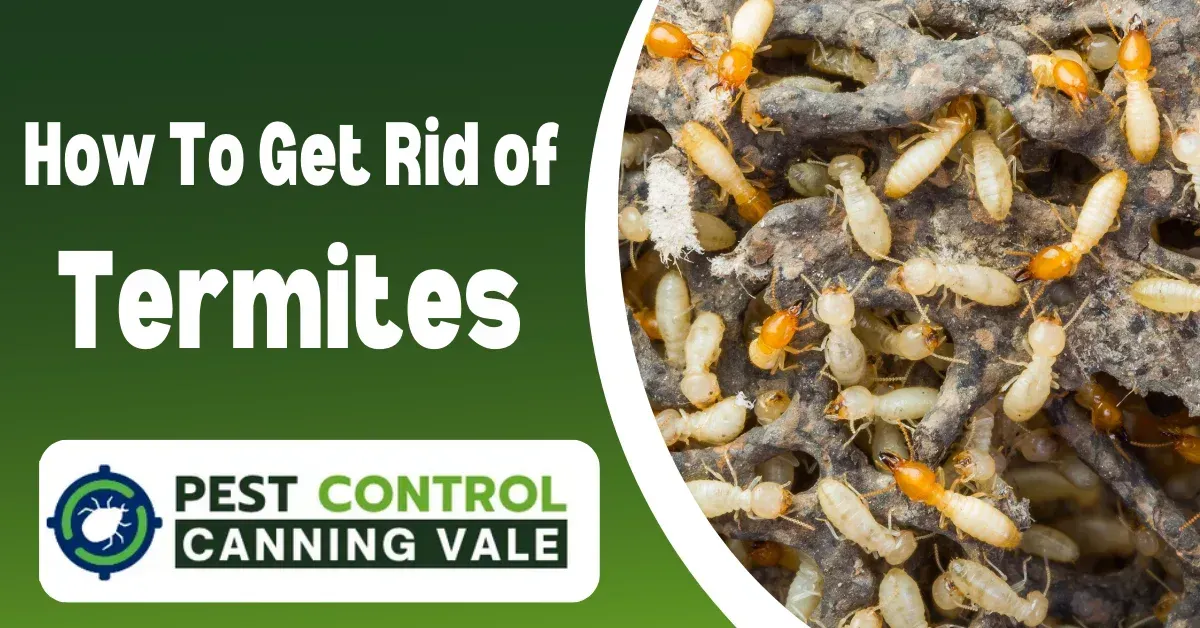PEST CONTROL CANNING VALE, THORNLIE, PARKWOOD, HARRISDALE, PIARA WATERS, WILLETTON AND SURROUNDING AREAS FOR OVER 10YRS
PEST CONTROL CANNING VALE, THORNLIE, PARKWOOD, HARRISDALE, PIARA WATERS, WILLETTON AND SURROUNDING AREAS FOR OVER 10YRS
Blogs

How to Get Rid of Termites
The Ultimate Guide How to Get Rid of Termites
Termites, affectionately known as white ants, are quite the sneaky little critters that can wreak havoc on your home if left unchecked. But don't worry! We've put together a detailed guide to help you tackle these unwelcome guests effectively, covering everything from identifying them to various treatment methods. Whether you're a fan of DIY solutions or prefer calling in the pros for termite pest control, we've got all the information you'll need.
Understanding Termites: What Are They Really?
Termites are small, pale insects that thrive in colonies and munch on cellulose, which is found in wood and other plant materials. Despite their nickname 'white ants,' they aren't really ants at all! There are a few different types of termites that you might encounter:
Subterranean Termites: These guys live underground and create mud tubes to reach food sources above ground. They are known for being particularly destructive.
Drywood Termites: Unlike their subterranean cousins, these termites live in dry wood and don’t need soil contact, often setting up shop in wooden structures, furniture, and hardwood floors.
Dampwood Termites: Preferring moist and decaying wood, these termites are usually found in damp places and are less common in homes but can still cause considerable damage if they make themselves at home.
Spotting a Termite Infestation
Catching a termite problem early can save you a lot of hassle and money. Here are some tell-tale signs to watch out for:
Mud Tubes: These are built by subterranean termites on walls and foundations to travel between their nest and their food sources.
Wood Damage: Termites eat wood from the inside out, so damaged wood might sound hollow if you tap on it.
Swarmers: These are winged termites that appear during mating season. Finding discarded wings near your windowsills or lights could indicate an infestation.
Frass: This is a fancy term for termite droppings, which look like small pellets and can accumulate near infested areas.
DIY Termite Treatment Methods
For those of you who like to tackle problems on your own, here are some effective DIY termite treatment options:
Reduce Moisture: Fix leaks and improve drainage around your home to make it less attractive to moisture-loving termites.
Remove Wood Debris: Keep firewood and other wooden materials away from your home’s foundation and clear out any stumps or dead trees from your yard.
Seal Entry Points: Seal up cracks and gaps in your home's exterior to keep termites from getting in.
Termite Baits and Barriers: You can install physical barriers like stainless steel mesh or use chemical barriers. Termite bait stations can also be effective; they contain slow-acting poison that termites bring back to their colony.
When to Call the Professionals
If you’re facing a severe infestation or DIY methods just aren’t cutting it, it might be time to call in professional termite pest control services. Here’s what you can expect:
Thorough Inspection: A professional will assess the extent of the infestation and locate all termite colonies.
Treatment Options: They might use a variety of methods such as liquid termiticides, termite baits, or even whole-structure fumigation for serious infestations.
Follow-Up and Prevention Tips: Professionals will not only help get rid of termites but also offer advice on how to prevent future infestations.
Preventing Future Termite Infestations
The best defense is a good offense! Here are some preventive measures to keep termites at bay:
Maintain Your Home: Regularly check for and repair leaks, seal up cracks, and manage moisture levels in your home.
Manage Your Yard: Remove potential termite food sources like dead wood, keep vegetation trimmed back from your home, and ensure proper drainage in your yard.
Keep It Clean: Regular cleaning can go a long way in preventing termite infestations. Make sure to vacuum hidden spots like baseboards and closets.
Remember, staying vigilant and proactive can save you a lot of trouble down the road. Whether you decide to DIY or call in the experts, you’re now equipped with the knowledge to protect your home from termites. Happy termite hunting!
Frequently Asked Questions (FAQs)
1. How do termites enter homes?
Termites can enter homes through cracks, gaps, and openings in the foundation, walls, and roof. They can also gain access through wood-to-soil contact, such as wooden structures touching the ground.
2. Are termites harmful to humans?
While termites do not pose a direct threat to humans, they can cause significant structural damage to buildings, which can be costly to repair. Their presence can also decrease the value of a property.
3. Can termites live in dry environments?
Different types of termites prefer different environments. Drywood termites can infest dry wood and do not require contact with the soil, while subterranean and dampwood termites prefer moist environments.
4. How long does it take to get rid of termites?
The time required to eliminate termites depends on the extent of the infestation and the treatment method used. Professional treatments often provide faster and more effective results, typically within a few weeks to a few months.
5. Can termites return after treatment?
Termites can return if entry points are not properly sealed and moisture levels are not controlled. Regular inspections and preventive measures are crucial to avoid reinfestation.
6. Is professional termite pest control expensive?
The cost of professional termite pest control varies based on the severity of the infestation and the treatment method used. While it can be more expensive than DIY methods, professional pest control often provides more effective and long-lasting results
Don't let termites ruin your peace of mind. Call Canning Vale pest control Today (08) 6373 2514
Canning Vale Pest Control
Nicholson Ct, Canning Vale WA 6155
(08) 6373 2514
Open 24 hours

